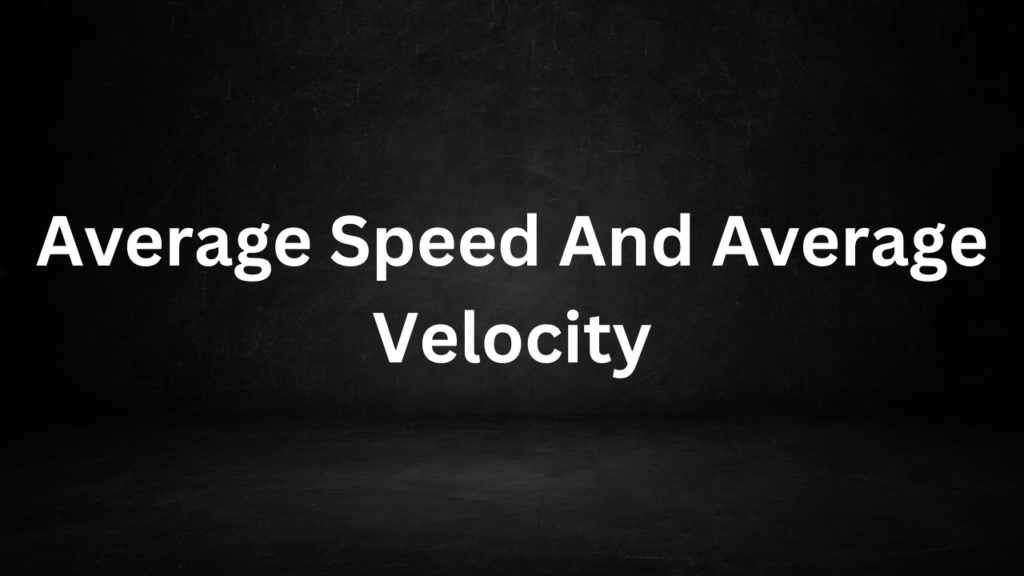Tag: Average Speed And Average Velocity
Average Speed And Average Velocity
Average Speed And Average Velocity In the realm of physics, both average speed and average velocity are concepts used to describe motion. Despite their similarities, they have distinct meanings and implications.

Average Speed:
Average speed is a scalar quantity that measures the overall rate at which an object covers distance during its entire journey. It is calculated by dividing the total distance traveled by the total time taken. The formula for average speed is:
Average Speed=Total Distance Total Time
Average speed provides an overview of how fast an object moves on average, without considering its direction. For instance, if a car travels 200 kilometers in 4 hours, its average speed would be 50 kilometers per hour (km/h).
Average Velocity:
Average velocity is a vector quantity that combines both the magnitude (speed) and direction of an object’s displacement over a specific time interval. It is the change in position divided by the change in time. The formula for average velocity is:
Average Velocity=Displacement Time Interval
Unlike average speed, average velocity considers the displacement of an object from its initial position to its final position. If a person moves 50 meters eastward and then returns 30 meters westward in 10 seconds, their average velocity would be 50 m−30 m10 s=2 m/s to the east.
Key Differences:
- Scalar vs. Vector: Average speed is a scalar quantity that only involves magnitude, while average velocity is a vector quantity that incorporates both magnitude and direction.
- Consideration of Direction: Average speed does not consider direction, whereas average velocity takes both direction and magnitude into account.
- Example: Imagine a car moving in a circular path. If the car returns to its starting point after some time, its average speed over that time might be significant, but its average velocity will be zero because the displacement is zero.
In conclusion, average speed characterizes the overall rate of motion without considering direction, while average velocity provides a more comprehensive picture by including both the direction and magnitude of displacement.
Both concepts are vital tools for describing and understanding the complexities of motion in physics.
Vector Nature:
The vector nature of average velocity makes it a more comprehensive representation of motion. It conveys not only how far something has traveled but also the path it took to get there. This is crucial when you’re interested in the object’s overall movement pattern.
Constant Speed vs. Changing Speed:
Average speed doesn’t differentiate between segments of motion with varying speeds. For example, if a car travels at 30 km/h for half the journey and 60 km/h for the other half, its average speed is 45 km/h (total distance divided by total time).
On the other hand, average velocity accounts for changes in speed and direction, giving you a better understanding of how the object moves overall.
In essence, while both average speed and average velocity offer insights into motion, their considerations of direction and displacement set them apart. The choice of which to use depends on the specific context and what aspects of motion you’re seeking to understand.
Read More
- Differences Between Acceleration And Velocity
- Matter In Our Surroundings Class 9 Summary
- Class 9th Chapter 2 Science Question Answer of NCERT
- NCERT Physics Class 9 Chapter 1 Solutions PDF Download
- CBSE Previous Year Question Papers Class 9 Science
Frequently Asked Questions – FAQs
What is the difference between average speed and average velocity?
Average speed is a scalar quantity that represents the total distance traveled divided by the total time taken, without regard to direction. Average velocity is a vector quantity that accounts for both the displacement and direction of an object’s motion over a specific time interval.
Can average speed be greater than average velocity?
Yes, average speed can be greater than average velocity. This can occur when an object covers a considerable distance in a given time interval, but its overall displacement is relatively small or zero due to changes in direction.
Is the magnitude of average velocity always equal to average speed?
Not necessarily. While the magnitude of average velocity (absolute value) can be equal to average speed in cases where motion is unidirectional, it can differ when there are changes in direction during the motion.
What does a negative average velocity signify?
A negative average velocity indicates that the object has moved in the opposite direction of its initial reference point. It signifies that the displacement has occurred in the negative direction of the coordinate system.
How is average velocity calculated when the direction changes?
When the direction changes, you need to consider the total displacement, not just the total distance traveled. Calculate the difference between the initial and final positions, and then divide it by the total time taken.